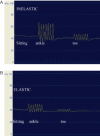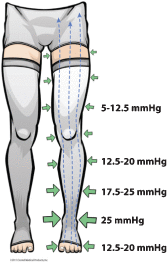Dogmas and controversies in compression therapy: report of an International Compression Club (ICC) meeting, Brussels, May 2011
- PMID: 22716023
- PMCID: PMC7950441
- DOI: 10.1111/j.1742-481X.2012.01009.x
Dogmas and controversies in compression therapy: report of an International Compression Club (ICC) meeting, Brussels, May 2011
Abstract
The International Compression Club (ICC) is a partnership between academics, clinicians and industry focused upon understanding the role of compression in the management of different clinical conditions. The ICC meet regularly and from these meetings have produced a series of eight consensus publications upon topics ranging from evidence-based compression to compression trials for arm lymphoedema. All of the current consensus documents can be accessed on the ICC website (http://www.icc-compressionclub.com/index.php). In May 2011, the ICC met in Brussels during the European Wound Management Association (EWMA) annual conference. With almost 50 members in attendance, the day-long ICC meeting challenged a series of dogmas and myths that exist when considering compression therapies. In preparation for a discussion on beliefs surrounding compression, a forum was established on the ICC website where presenters were able to display a summary of their thoughts upon each dogma to be discussed during the meeting. Members of the ICC could then provide comments on each topic thereby widening the discussion to the entire membership of the ICC rather than simply those who were attending the EWMA conference. This article presents an extended report of the issues that were discussed, with each dogma covered in a separate section. The ICC discussed 12 'dogmas' with areas 1 through 7 dedicated to materials and application techniques used to apply compression with the remaining topics (8 through 12) related to the indications for using compression.
Keywords: Compression bandages; Compression stockings; Intermittent pneumatic compression; Leg ulcers; Lipoedema; Lymphoedema.
© 2012 The Authors. International Wound Journal © 2012 John Wiley & Sons Ltd and Medicalhelplines.com Inc.
Figures





References
-
- Uhl JF. 3D multislice CT to demonstrate the effects of compression therapy. Int Angiol 2010;29:411–5. - PubMed
-
- Partsch H, Mosti G, Mosti F. Narrowing of leg veins under compression demonstrated by magnetic resonance imaging (MRI). Int Angiol 2010;29:408–10. - PubMed
-
- Downie SP, Firmin DN, Wood NB, Thom SA, Hughes AD, Wolfe JN, Xu XY. Role of MRI in investigating the effects of elastic compression stockings on the deformation of the superficial and deep veins in the lower legs. J Magn Reson Imaging 2007;26:80–5. - PubMed
-
- Mosti G, Partsch H. Compression stockings with a negative pressure gradient have a more pronounced effect on venous pumping function than graduated elastic compression stockings. Eur J Vasc Endovasc Surg 2011;42:261–6. - PubMed
-
- Couzan S, Prufer M, Ferret JM, Mismetti P, Pouget JF. A new concept of support‐compression: application of colour echo‐doppler, with venous pressure measurements and MRI. Phlébologie 2002;55:159–70.
Publication types
MeSH terms
LinkOut - more resources
Full Text Sources
Other Literature Sources
Medical
Miscellaneous

